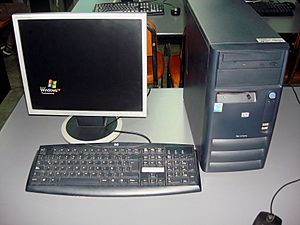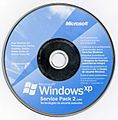Windows XP facts for kids
 |
|

Windows XP running on a computer
|
|
| Developer | Microsoft Corporation |
|---|---|
| OS family | Microsoft Windows |
| Source model | Closed source, Shared source |
| Released to manufacturing |
1999 (as a beta version/Microsoft Windows Codename Whistler) August 24, 2001 |
| General availability |
October 25, 2001 |
| Latest release | 5.1 (Build 2600: Service Pack 3) / April 21, 2008 |
| Repository |
|
| Update method | Windows Update Windows Server Update Services (WSUS) System Center Configuration Manager (SCCM) |
| Platforms | IA-32, x86-64 and Itanium |
| Kernel type | Hybrid |
| License | Proprietary commercial software |
| Preceded by | Windows 2000 (2000) Windows ME (2000) |
| Succeeded by | Windows Vista (2007) |
| Support status | |
| Support ended on April 8, 2014 | |
Windows XP is a version of the Microsoft Windows operating system for personal computers. The letters "XP" stand for eXPerience. Microsoft released Windows XP on October 25, 2001. It replaced older versions like Windows 2000 and Windows ME. This helped bring together different Windows technologies. Later, Windows Vista replaced Windows XP.
Windows XP was very popular. In April 2012, it was the second most used computer operating system in the world. Many computer makers like Dell, Hewlett Packard, and Acer sold their computers with Windows XP. If a laptop from that time has the old Windows logo on its Windows (WIN) key, it might have originally come with Windows 2000.
Microsoft stopped supporting Windows XP on April 8, 2014. This means they no longer provide regular updates or help. Even so, Windows XP stayed popular for a long time. By August 2019, Microsoft also stopped supporting games on Windows XP. As of October 2019, a small number of Windows PCs still used Windows XP. From 2001 to 2007, Windows XP was the most popular operating system. It sold over 500 million copies.
Contents
- What Are the Different Versions of Windows XP?
- Home Edition: For Everyday Users
- Professional Edition: For Businesses and Advanced Users
- Media Center Edition: For Entertainment
- Tablet PC Edition: For Pen-Based Devices
- 64-bit Edition: For Powerful Computers
- Professional x64 Edition: For Modern 64-bit Computers
- Starter Edition: For Developing Countries
- What Do You Need to Run Windows XP?
- Related pages
- Images for kids
- See also
What Are the Different Versions of Windows XP?
Windows XP came in several versions, each made for different users.
Home Edition: For Everyday Users
Home Edition was made for people who use computers at home. It had all the basic features for daily tasks.
Professional Edition: For Businesses and Advanced Users
Professional was designed for businesses and people who needed more power. It had advanced features like backup tools and could work with two CPUs.
Media Center Edition: For Entertainment
Media Center Edition was for people who wanted to use their computer like a TV or music player. It included Windows Media Center. This program could manage TV shows, play music, and even stream movies.
Tablet PC Edition: For Pen-Based Devices
Tablet PC Edition was made for early tablet PCs and laptops that used a special pen.
64-bit Edition: For Powerful Computers
64-bit Edition was for computers with special Intel 64-bit processors called Itanium. It had fewer features than Windows XP Professional. For example, it could not run very old 16-bit programs.
Professional x64 Edition: For Modern 64-bit Computers
Professional x64 Edition was for computers with newer 64-bit x86-based processors. It had most of the features of Windows XP Professional. It also allowed 32-bit programs to run on a 64-bit system.
Starter Edition: For Developing Countries
Starter Edition was sold mainly in developing countries. It was cheaper because Microsoft wanted to help reduce software piracy. You could only buy it with a new computer.
What Do You Need to Run Windows XP?
To run Windows XP Home or Professional, your computer needed to meet certain system requirements.
| Minimum Needed | Recommended | |
|---|---|---|
| Processor | 233 MHz | 300 MHz or faster |
| Memory | 64 MB RAM (might slow things down) | 128 MB RAM or more |
| Screen and Graphics | Super VGA (800 x 600) | Super VGA (800 x 600) or higher |
| Hard Drive Space | 1.5 GB | 1.5 GB or more |
| Drives | CD-ROM or DVD-ROM | CD-ROM or DVD-ROM |
| Devices | Keyboard | Keyboard and mouse |
| Other | Sound card, speakers, and headphones | Sound card, speakers, and headphones |
Related pages
| Preceded by Windows 2000 |
Windows Versions 2001-2007 |
Succeeded by Windows Vista |
Images for kids
-
An electroencephalograph running on Windows XP. Some medical machines still use Windows XP because their special programs only work on it.
See also
 In Spanish: Windows XP para niños
In Spanish: Windows XP para niños




